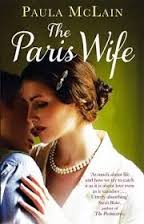BELOW IS AN article about Paula McLain’s historical novel about Hemingway’s third wife, Journalist Martha Gellhorn. Photos added by me. Best, Christine

Cleveland Heights Author Highlights Hemingway’s Competition with Third Wife Gellhorn (By Dan Polletta in IDEASTREAMING)
It might sound like a cliché, but the subject for Paula McLain’s new novel “Love and Ruin” (Random House) came to her in a dream.
After penning “The Paris Wife,” the best-seller about Ernest Hemingway’s first wife Hadley Richardson, McLain had no intention of writing any more about Hemingway until she dreamt of being on a fishing boat with him and his third wife Martha Gellhorn.
The next day McLain researched Gellhorn on the internet. She admits to being “embarrassed” about how little she knew about her.
“I knew she was a journalist, but not that she was perhaps the most important journalistic voice of the 20th century, that her career as a journalist and war correspondent covered 60 years, every major conflict of the 20th century. Of course, as we know, journalism and being a war correspondent was absolutely a man’s world, so it was an extraordinary feat in itself, let alone that her voice was so iconic and her accomplishments so everlasting,” McLain said.
The 28-year-old Gellhorn, who had done some cub reporting for the Albany “Times Union,” met her literary hero in a Key West bar at the end of 1936.
“She literally bumped into Hemingway in his own watering hole, ‘Sloppy Joe’s.’ He was there reading his mail. He was about to go off to report on the Spanish Civil War for the North American Newspaper Alliance,” McLain said.
McLain said Gellhorn saw meeting Hemingway, who was heading to a war that many saw as romantic, as her chance to attach herself to “noble and larger than herself.” She agreed to go with him to Spain, where she too would cover the war.
During her time reporting from Madrid, Gellhorn found her journalistic voice and fell in love with Hemingway.

From 1936 until 1940, the two lived together off and on until they married. During that time Gellhorn covered the rise of Adolph Hitler in Germany as well as Czechoslovakia a few months before sections of it were annexed by the Nazis. She wrote about that experience in her 1940 novel “A Stricken Field.”
That same year Hemingway also published his novel “For Whom the Bell Tolls.” McLain said it was a major turning point in both of their lives.
“Hemingway was already quite famous at that point, but this book catapulted him into literary stardom. I can’t really imagine what it would have been like for her, under his roof, also trying to be a writer. She was trying to get her own literary ambitions realized. She loved her own books, as he loved his. She devoted herself to her novels and stories but of course didn’t have the success. Hemingway became completely involved in “For Whom the Bell Tolls,” which I think changed his life. The book became the focal point of their lives. It took all of the air and all of their attention.”
McLain said the book’s overwhelming presence in their lives started the process of driving them apart.

“I think Hemingway forgot what attracted him to Gellhorn when he first met her. Here was this incredible woman, so bold. He called her ‘the bravest woman he had ever met.’ She was clearly ambitious. Yet, once she became his wife, that ambition and devotion to her own career, that independence began to threaten him,” McLain said.
In 1944, Hemingway, feeling more and more abandoned when Gellhorn went off to cover war, offered his services to “Collier’s” magazine, for whom Gellhorn wrote. “Collier’s” accepted, replacing Gellhorn with Hemingway, just as she was preparing to go Normandy in 1944 to cover the D-Day invasion.
“She had no magazine for which to report, no credentials, no way to get over to the most important battle in history. Instead of rolling over, she found a way over to Europe on an ammunitions barge. When she got to London, she stowed away on what proved to be a hospital barge, which she didn’t know. She lied her way onto ship, locked herself in the john, and when she woke up she discovered she was on the first hospital barge for the Normandy Invasion,” McLain said.

McLain said Gellhorn going overseas in spite of Hemingway’s attempts to stop her was the breaking point of their relationship.
“They don’t recover after that. He really never forgave her. Of his four wives, she’s the only one to leave, and she’s really the only one who is his equal in every way. When they split in 1945, Gellhorn made it a point to never have his name spoken in her presence. She said ‘I don’t believe I should be remembered as footnote to anyone else’s life,’” McLain said.
Paula McLain will discuss her book at these Northeast Ohio locations this weekend
